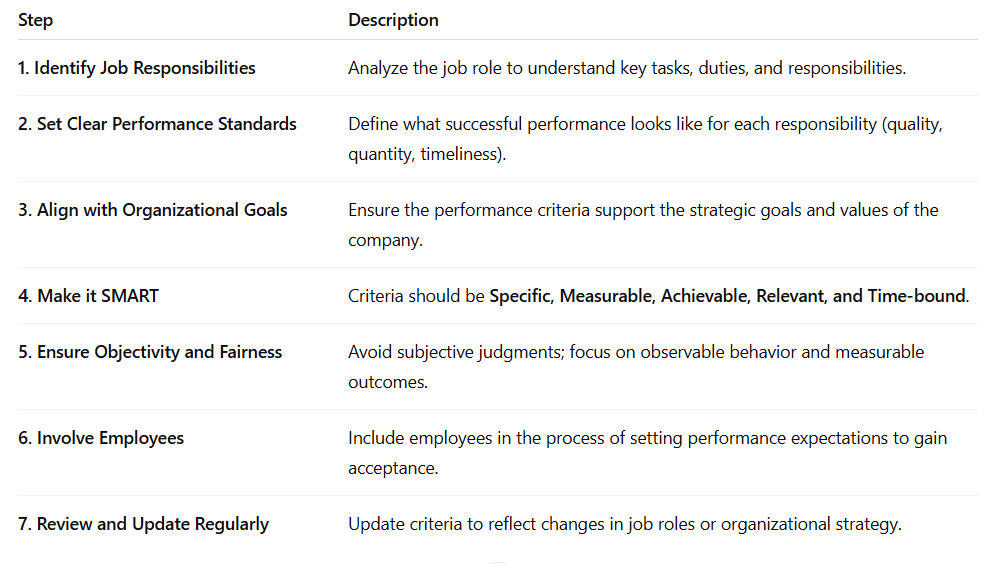Unit 1: Introduction to Performance Management System
Introduction to Performance Management System
Meaning of Performance Management System (PMS):
A Performance Management System is a process used by organizations to monitor, evaluate, and improve the performance of employees to ensure that their goals align with the overall objectives of the company. It is not just about appraisals or evaluations, but a continuous process of setting goals, giving feedback, and developing employee skills.
Uses of Performance Management System:
- Employee Development: Helps identify strengths and areas of improvement in employees.
- Goal Alignment: Ensures that individual and team goals support the company’s vision and objectives.
- Improved Communication: Promotes regular interaction between managers and employees.
- Decision Making: Provides data for promotions, bonuses, training, and terminations.
- Motivation: Encourages employees to perform better through recognition and rewards.
- Organizational Growth: Enhances productivity and contributes to the success of the organization.
Purpose of Performance Management:
- 🎯 Set Clear Expectations: Define roles, responsibilities, and expected outcomes.
- 💬 Continuous Feedback: Provide regular feedback to guide and improve performance.
- 📈 Performance Improvement: Identify gaps and take steps to enhance performance.
- 🧠 Skill Development: Identify training needs and support learning and growth.
- 💰 Fair Compensation Decisions: Base salary increases, incentives, and promotions on performance data.
- 🏆 Recognition and Reward: Acknowledge and reward high performers.
Summary
- Performance Management is a comprehensive and continuous process aimed at developing and managing performance throughout the year.
- Performance Appraisal is a part of performance management that specifically deals with evaluating employee performance over a specific time period.
Performance Management and Its Challenges in Current Scenario
Performance Management is a continuous process of setting goals, monitoring progress, providing feedback, and improving employee performance to align with organizational objectives. It includes activities like goal setting, coaching, performance review, training, and development.
⚠️ Challenges in Performance Management (Current Scenario)
How to Overcome These Challenges?
- Use digital and cloud-based performance management tools.
- Promote continuous feedback and communication.
- Set flexible and adaptive performance goals.
- Train managers for unbiased and effective appraisals.
- Focus on employee well-being and mental health.
- Involve employees in goal setting and performance planning.
Performance Management as a System and Process
A system is a set of connected elements working together. So, Performance Management as a System means it includes all the tools, people, strategies, and processes used to improve employee performance and align it with organizational goals.
🔁 Key Components of the Performance Management System:
Performance Management as a Process:
A process is a sequence of steps followed over time. Performance Management as a Process involves a cycle of continuous actions aimed at improving employee and organizational performance.
📘 Steps in the Performance Management Process:
- Planning: Set clear job expectations and performance goals.
- Monitoring: Regularly observe and measure progress against goals.
- Developing: Provide training and career development support.
- Rating: Evaluate employee performance during appraisal sessions.
- Rewarding - Recognize good performance through promotions, raises, or awards.
🎯 Conclusion:
As a system, performance management connects all related elements for managing and improving performance. As a process, it follows a cycle of planning, monitoring, evaluating, and rewarding employees.
Establishing Performance Criterion for Developing an Effective Appraisal System
Performance Criteria are the standards or benchmarks used to evaluate an employee’s job performance. These criteria define what "good performance" looks like and are essential for making the appraisal process fair, objective, and effective.
🎯 Key Steps in Establishing Performance Criteria:
Examples of Performance Criteria:
Benefits of Setting Clear Performance Criteria
- Improves fairness and transparency in appraisals
- Enhances employee motivation and accountability
- Supports better feedback and coaching
- Helps in identifying training and development needs
- Strengthens decision-making for promotions and rewards
📌 Conclusion
Performance Management Criteria: KRA, KSA vs KPI
1. KRA (Key Result Area)
- These are the core areas where an employee must deliver results.
- They are aligned with company goals and job roles.
- Not always numeric, but they define responsibility areas.
2. KSA (Knowledge, Skills, and Abilities)
- Represents the competencies required to perform job duties successfully.
- Helps in training and development planning.
3. KPI (Key Performance Indicator)
- Specific, measurable targets that evaluate success in a role.
- Used to track performance quantitatively.
- Directly derived from KRAs.






